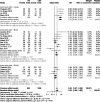The Safety and Efficacy of Flow Diversion versus Conventional Endovascular Treatment for Intracranial Aneurysms: A Meta-analysis of Real-world Cohort Studies from the Past 10 Years
- PMID: 35710123
- PMCID: PMC9262058
- DOI: 10.3174/ajnr.A7539
The Safety and Efficacy of Flow Diversion versus Conventional Endovascular Treatment for Intracranial Aneurysms: A Meta-analysis of Real-world Cohort Studies from the Past 10 Years
Abstract
Background: Although the flow diverter has advantages in the treatment of intracranial aneurysms, pooled studies that directly compare it with conventional endovascular treatments are rare.
Purpose: Our aim was to compare the safety and efficacy of flow-diverter and conventional endovascular treatments in intracranial aneurysms.
Data sources: We performed a comprehensive search of the literature using PubMed, EMBASE, and the Cochrane Database.
Study selection: We included only studies that directly compared the angiographic and clinical outcomes of flow-diverter and conventional endovascular treatments.
Data analysis: Random effects or fixed effects meta-analysis was used to pool the cumulative rate of short- and long-term angiographic and clinical outcomes.
Data synthesis: Eighteen studies with 1001 patients with flow diverters and 1133 patients with conventional endovascular treatments were included; 1015 and 1201 aneurysm procedures were performed, respectively. The flow-diverter group had aneurysms of a larger size (standard mean difference, 0.22; 95% CI, 0.03-0.41; P = .026). There was a higher risk of complications in the flow-diverter group compared with the conventional endovascular group (OR, 1.4; 95% CI, 1.01-1.96; P = .045) during procedures. The follow-up angiographic results of flow-diverter treatment indicated a higher rate of complete occlusion (OR, 2.55; 95% CI, 1.70-3.83; P < .001) and lower rates of recurrence (OR, 0.24; 95% CI, 0.12-0.46; P < .001) and retreatment (OR, 0.31; 95% CI, 0.21-0.47; P < .001).
Limitations: Limitations include a retrospective, observational design in some studies, high heterogeneity, and selection bias.
Conclusions: Compared with the conventional endovascular treatments, the placement of a flow diverter may lead to more procedure-related complications, but there is no difference in safety, and it is more effective in the long term.
© 2022 by American Journal of Neuroradiology.
Figures




Similar articles
-
Safety and Efficacy of Low-Profile Braided Stents versus Flow Diverters in the Reconstructive Technique in the Treatment of Patients with Vertebrobasilar Dolichoectasia Aneurysms: A Cohort of 47 Patients with Long-Term Follow-Up.AJNR Am J Neuroradiol. 2024 Feb 7;45(2):176-182. doi: 10.3174/ajnr.A8091. AJNR Am J Neuroradiol. 2024. PMID: 38238095 Free PMC article.
-
Acutely Ruptured Intracranial Aneurysms Treated with Flow-Diverter Stents: A Systematic Review and Meta-Analysis.AJNR Am J Neuroradiol. 2018 Sep;39(9):1669-1675. doi: 10.3174/ajnr.A5730. Epub 2018 Jul 26. AJNR Am J Neuroradiol. 2018. PMID: 30049721 Free PMC article.
-
Flow diverter retreatment for intracranial aneurysms: A meta-analysis of efficacy and feasibility.Interv Neuroradiol. 2024 Feb;30(1):37-42. doi: 10.1177/15910199221095972. Epub 2022 May 3. Interv Neuroradiol. 2024. PMID: 35505615 Free PMC article.
-
Treatment of Unruptured Distal Anterior Circulation Aneurysms with Flow-Diverter Stents: A Meta-Analysis.AJNR Am J Neuroradiol. 2019 Apr;40(4):687-693. doi: 10.3174/ajnr.A6002. Epub 2019 Mar 14. AJNR Am J Neuroradiol. 2019. PMID: 30872418 Free PMC article.
-
Treatment of Distal Anterior Cerebral Artery Aneurysms with Flow-Diverter Stents: A Single-Center Experience.AJNR Am J Neuroradiol. 2018 Jun;39(6):1100-1106. doi: 10.3174/ajnr.A5615. Epub 2018 Apr 12. AJNR Am J Neuroradiol. 2018. PMID: 29650782 Free PMC article.
Cited by
-
In reply.Eur Stroke J. 2023 Jun;8(2):602-603. doi: 10.1177/23969873231156064. Epub 2023 Feb 7. Eur Stroke J. 2023. PMID: 37231680 Free PMC article. No abstract available.
-
Flow diverter with or without adjunctive coils in the treatment of large and giant intracranial aneurysms: a meta-analysis.Neurosurg Rev. 2025 Jun 20;48(1):519. doi: 10.1007/s10143-025-03675-y. Neurosurg Rev. 2025. PMID: 40540033
-
A novel flow diverter device (Tubridge) for the treatment of intracranial aneurysms: a systematic review and meta-analysis.Neurosurg Rev. 2023 Aug 10;46(1):198. doi: 10.1007/s10143-023-02100-6. Neurosurg Rev. 2023. PMID: 37561213
-
Appraisal of the Flow Diversion Effect Provided by Braided Intracranial Stents.J Clin Med. 2024 Jun 11;13(12):3409. doi: 10.3390/jcm13123409. J Clin Med. 2024. PMID: 38929937 Free PMC article.
-
Reconstructive endovascular treatment for basilar artery trunk aneurysms: complications and clinical and angiography outcomes.J Neurointerv Surg. 2023 Dec;15(12):1194-1200. doi: 10.1136/jnis-2022-019864. Epub 2023 Jan 13. J Neurointerv Surg. 2023. PMID: 36639233 Free PMC article.
References
-
- Moret J, Cognard C, Weill A, et al. . Reconstruction technic in the treatment of wide-neck intracranial aneurysms: long-term angiographic and clinical results—apropos of 56 cases. J Neuroradiol 1997;24:30–44 - PubMed
Publication types
MeSH terms
LinkOut - more resources
Full Text Sources
Medical
Miscellaneous
